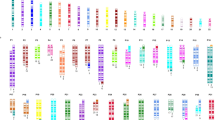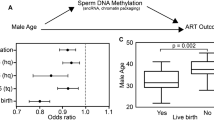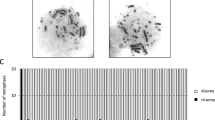Abstract
This study explores the relationship between sperm structural aberrations and age by using a multicolor multichromosome FISH strategy that provides information on the incidence of duplications and deletions on all the autosomes. ToTelvysion kit (Abbott Molecular, Abbott Park, IL, USA) with telomere-specific probes was used. We investigated the sperm of 10 male donors aged from 23 to 74 years old. The donors were divided into two groups according to age, a cohort of five individuals younger than 40 and a cohort of five individuals older than 60 years. The goal of this study was to determine (1) the relationship between donor age and frequency and type of chromosome structural abnormalities and (2) chromosomes more frequently involved in sperm structural aberrations. We found that the older patients had a higher rate of structural abnormalities (6.6%) compared with the younger cohort (4.9%). Although both duplications and deletions were seen more frequently in older men, our findings demonstrate the presence of an excess of duplications versus deletions in both groups at a ratio of 2 to 1. We demonstrate that the distribution of duplications and deletions was not linear along the chromosomes, although a trend toward a higher rate of abnormalities in larger chromosomes was observed. This work is the first study addressing the frequencies of sperm chromosome structural aberrations of all autosomes in a single assay thus making a contribution to the clarification of the amount and origin of damage present in human spermatozoa and in relation to age.
Similar content being viewed by others
Log in or create a free account to read this content
Gain free access to this article, as well as selected content from this journal and more on nature.com
or
References
Jacobs PA : The chromosome complement of human gametes. Oxf Rev Reprod Biol 1992; 14: 47–72.
Hassold TJ : Nondisjunction in the human male. Curr Top Dev Biol 1998; 37: 383–406.
Olson SD, Magenis RE : Preferential paternal origin of de novo structural rearrangements. In: Daniel A (ed): The Cytogenetics of Mammalian Autosomal Rearrangements. New York: Alan R Liss, 1988, pp 583–599.
Thomas NS, Durkie M, Van Zyl B et al: Parental and chromosomal origin of unbalanced de novo structural chromosome abnormalities in man. Hum Genet 2006; 119: 444–450.
Cody JD, Perce JF, Brkanac Z et al: Preferential loss of the paternal alleles in the 18q- syndrome. Am J Hum Genet 1997; 69: 280–286.
Dallapiccola B, Mandich P, Bellone E et al: Parental origin of chromosome 4p deletions in Wolf-Hirschhorn syndrome. Am J Med Genet 1993; 47: 921–924.
Overhauser J, McMahon J, Oberlender S et al: Parental origin of chromosome 5 deletions in the Cri-Du-Chat syndrome. Am J Med Genet 1990; 37: 83–88.
De Gregori M, Ciccone R, Magini P et al: Cryptic deletions are a common finding in “balanced” reciprocal and complex chromosome rearrangements: a study of 59 patients. J Med Genet 2007; 44: 750–762.
Baptista J, Mercer C, Prigmore E et al: Breakpoint mapping and array CGH in translocations: comparison of a phenotypically normal and an abnormal cohort. Am J Hum Genet 2008; 82: 927–936.
Kurahashi H, Bolor H, Kato T et al: Recent advance in our understanding of the molecular nature of chromosomal abnormalities. J Hum Genet 2009; 54: 253–260.
Ohye T, Inagaki H, Kogo H et al: Paternal origin of the de novo constitutional t(11;22)(q23;q11). Eur J Hum Genet 2010; 18: 783–787.
Thomas NS, Morris JK, Baptista J, Ng BL, Crolla JA, Jacobs PA : De novo apparently balanced translocations in man are predominantly paternal in origin and associated with a significant increase in paternal age. J Med Genet 2010; 47: 112–115.
Martin RH, Rademaker AW, Hildebrand K, Long-Simpson L, Peterson D, Yamamoto J : Variation in the frequency and type of sperm chromosomal abnormalities among normal men. Hum Genet 1987; 77: 108–114.
Brandriff BF, Gordon LA, Moore II D, Carrano AV : An analysis of structural aberrations in human sperm chromosomes. Cytogenet Cell Genet 1988; 47: 29–36.
Estop AM, Marquez C, Munne S et al: An analysis of human sperm breakpoints. Am J Hum Genet 1995; 56: 452–460.
Templado C, Bosch M, Benet J : Frequency and distribution of chromosome abnormalities in human spermatozoa. Cytogenet Genome Res 2005; 111: 199–205.
Buwe A, Guttenbach M, Schmid M : Effect of paternal age on the frequency of cytogenetic abnormalities in human spermatozoa. Cytogenet Genome Res 2005; 111: 213–228.
Martin RH, Rademaker AW : The effect of age on the frequency of sperm chromosome abnormalities in normal men. Am J Hum Genet 1987; 41: 484–449.
Sartorelli EM, Mazzucatto LF, de Pina-Neto JM : Effect of paternal age on human sperm chromosomes. Fertil Steril 2001; 76: 1119–1123.
Brandriff B, Gordon L, Ashworth L et al: Chromosomes of human sperm: variability among normal individuals. Hum Genet 1885; 70: 18–24.
Rosenbusch B, Strehler E, Abt M, Sterzik K : Correlation between cytogenetic anomalies of human spermatozoa and sperm morphology as well as age of patients studied. Zentralbl Gynakol 1993; 115: 113–116.
Bosch M, Rajmil O, Egozcue J, Templado C : Linear increase of structural and numerical chromosome 9 abnormalities in human sperm regarding age. Eur J Hum Genet 2003; 11: 754–759.
Sloter ED, Marchetti F, Eskenazi B et al: Frequency of human sperm carrying structural aberrations of chromosome 1 increases with advancing age. Fertil Steril 2007; 87: 1077–1086.
Bosch M, Rajmil O, Egozcue J, Templado C : Linear increase of diploidy in human sperm with age: a four-colour FISH study. Eur J Hum Genet 2001; 9: 533–538.
Liang KY, Zeger SL : Longitudinal data analysis using generalized linear models. Biometrika 1986; 73: 13–22.
De la Chica RA, Ribas I, Giraldo J, Egozcue J, Fuster C : Chromosomal instability in amniocytes from fetuses of mothers who smoke. JAMA 2005; 293: 1212–1222.
Schmid TE, Brinkworth MH, Hill F et al: Detection of structural and numerical chromosomal abnormalities by ACM-FISH analysis in sperm of oligozoospermic infertility patients. Hum Reprod 2004; 19: 1395–1400.
Van Hummelen P, Lowe XR, Wyrobek AJ : Simultaneous detection of structural and chromosome abnormalities in sperm of healthy men by multicolor fluorescence in situ hybridization. Hum Genet 1996; 98: 608–615.
Baumgartner A, Van Hummelen P, Lowe XR, Adler ID, Wyrobek AJ : Numerical and structural chromosome abnormalities detected in human sperm with a combination of multicolor FISH assays. Environ Mol Mutagen 1999; 33: 49–58.
Sloter E, Lowe X, Moore DI, Nath J, Wyrobek AJ : Multicolor FISH analysis of chromosomal breaks, duplications, deletions, and numerical abnormalities in the sperm of healthy men. Am J Hum Genet 2000; 67: 862–872.
Uroz L, Rajmil O, Templado C : Meiotic chromosome abnormalities in fertile men: Are they increasing? Steril Fertil, 2010; doi:10.1016/j.fertnster2010.06.042.
Warburton PE : Chromosomal dynamics of human neocentromere formation. Chromosome Res 2004; 12 (6): 617–626.
Kato T, Yamada K, Inagaki H et al: Age has no effect on the de novo constitutional t(11;22) translocation frequency in sperm. Fertil Steril 2007; 88: 1446–1448.
Aitken RJ, Koopman P, Lewis SEM : Seeds of concern. Nature 2004; 432: 48–52.
Fratarelli JL, Miller KA, Miller BT, Elkin-Hirsch J, Scott Jr RT : Male age negatively impacts embryo development and reproductive outcome in donor oocyte assisted reproductive technology cycles. Fertil Steril 2008; 90: 97–103.
Tarozzi N, Bizarro D, Flamigni C, Borini A : Clinical relevance of sperm DNA damage in assisted reproduction. Reprod Biomed Online 2007; 14: 746–757.
Singh NP, Muller CH, Berger RE : Effects of age on DNA double-strand breaks and apoptosis in human sperm. Fertil Steril 2003; 80: 1420–1430.
Ravnan JB, Tepperberg JH, Papenhausen P et al: Subtelomere FISH analysis of 11 688 cases: an evaluation of the frequency and pattern of subtelomere rearrangements in individuals with developmental disabilities. J Med Genet 2006; 43: 478–489.
Knight SJ, Regan R, Nicod A et al: Subtle chromosomal rearrangements in children with unexplained mental retardation. Lancet 1999; 354 (9191): 1676–1681.
Martin CL, Waggoner DJ, Wong A et al: Molecular rulers for calibrating phenotypic effects of telomere imbalance. J Med Genet 2002; 39: 734–740.
Acknowledgements
This research was supported by the Ministerio de Ciencia e Innovación, Spain (SAF2007-65913) and the Generalitat de Catalunya, Spain (2005FI00399, 2009SGR-01107).
Author information
Authors and Affiliations
Corresponding author
Ethics declarations
Competing interests
The authors declare no conflict of interest.
Rights and permissions
About this article
Cite this article
Templado, C., Donate, A., Giraldo, J. et al. Advanced age increases chromosome structural abnormalities in human spermatozoa. Eur J Hum Genet 19, 145–151 (2011). https://doi.org/10.1038/ejhg.2010.166
Received:
Revised:
Accepted:
Published:
Issue date:
DOI: https://doi.org/10.1038/ejhg.2010.166
Keywords
This article is cited by
-
Breakpoints in complex chromosomal rearrangements correspond to transposase-accessible regions of DNA from mature sperm
Human Genetics (2023)
-
Predicting chromosome damage in astronauts participating in international space station missions
Scientific Reports (2021)
-
DNA damage in aging, the stem cell perspective
Human Genetics (2020)
-
Effects of increased paternal age on sperm quality, reproductive outcome and associated epigenetic risks to offspring
Reproductive Biology and Endocrinology (2015)
-
De novo deletions and duplications detected by array CGH: a study of parental origin in relation to mechanisms of formation and size of imbalance
European Journal of Human Genetics (2012)



